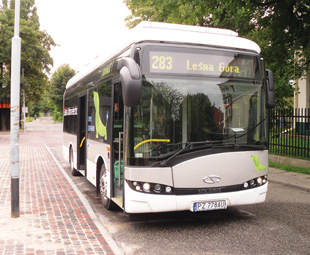Solaris pushes the electric bus envelope

FRANK BEETON reports on important bus news from overseas
It’s somewhat ironic that the world seems headed back to something that was well-established in the first half of the 20th Century but rapidly lost support during the second half – namely electric traction. Once the mould of the traditional fossil-fueled engine driving a live axle through a mechanical transmission had been broken, manufacturers seem to have become more receptive to the development of increasingly radical traction solutions.
Solaris Bus & Coach, founded in 1996 and located just north of Poznan in Poland, manufactures a wide range of modern city and suburban buses, trolley buses, special application vehicles and trams. Solaris buses currently operate in 22 European countries and can also be found in Russia and Dubai. The company’s product line-up, distinguished by an asymmetric windscreen design, is currently centred on the Urbino low floor/low entry urban and suburban buses, the Trollino trolley bus range, and the Tramino tram.
In 2012, Solaris unveiled an all-electric version of the Urbino in 8,9 m Alpino midibus format. This was powered by a Vossloh Kiepe 120 kW (160 hp) four-pole asynchronous traction motor fed by two liquid-cooled lithium-ion batteries, which were also used to energise the power steering, heating, ventilation and door control. The batteries were fed by a Walter plug-in connection, with a full recharge taking around four hours. The composite body structure was optimised to reduce any tare mass disadvantage caused by the 1 400 kg traction batteries, and modifications included using carbon fibre as the material for body side panels, motor cover and battery compartment cover. This vehicle subsequently entered service in Poznan for a period of 22 days during the staging of the Euro 2012 football championship, and was problem-free over an operating distance of 3 000 km. Further successful tests were conducted in Kassel and Warsaw.
Solaris has subsequently announced the availability of a 12 m low-floor version of the Urbino electric bus. It uses a centrally-mounted 160 kW (214 hp) output Vossloh Kiepe motor, driving a conventional ZF AV 132 portal axle. Recovered braking energy is stored in A123 lithium-ion batteries, while additional charging is carried out through a plug-in connection. However, Solaris also offers other methods of power replenishment through induction charging, pantograph charging from overhead catenary (similar to trolley bus functionality), or battery pack exchange. The vehicle follows the pattern set by its smaller predecessor in having all auxiliary systems, including Konvekta air-conditioning, operated by electrical power. The layout includes three doors and 32 seats, with total accommodation for 85 passengers. The claimed fully loaded operating range is 85 km.
The first Urbino electric 12 m bus is scheduled for delivery to Braunschweiger Verkehrs-AG in Germany during 2013. This vehicle will employ the Bombardier-developed induction charging option as part of a drive technology pilot programme funded by the German Federal Ministry of Transport. The next stage in Solaris’ development programme will include the development of a battery-powered articulated bus for a specific customer, using the all-electric drive concept.
It’s probably fair to say that the renewed interest in electric-powered public transport that has recently emerged was initially prompted by the need to develop new technology to support hybrid drivelines. It’s also noteworthy that the trams and trolley buses so popular during the first half of the century never completely disappeared. However, the latest developments suggest infinitely better interpretations of these transport modes, obtained via a rather circuitous evolutionary route!
Published by
Focus on Transport
focusmagsa




